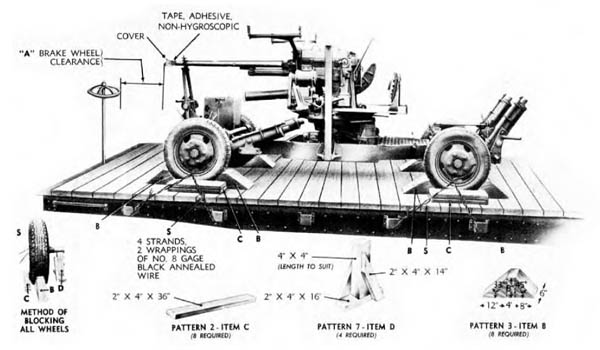Instructions for loading the 37-mm gun and carriage on railroad cars from the WWII technical manual TM 9-235 37-mm AA Gun Materiel, U.S. War Department, January, 1944.
LOADING MATERIEL ON RAILROAD CAR.
a. General. All loading and blocking instructions as specified herein are minimum, and are in accordance with the Association of American Railroads, “Rules Governing the Loading of Commodities on Open Top Cars,” special supplement, revised, 1, March 1943.
b. Instructions.
(1) INSPECTION. Railroad cars must be inspected to see that they are suitable to carry loads to destination. Floors must be sound and all loose nails or other projections not an integral part of the car should be removed.
(2) RAMPS. Permanent ramps should be used for loading the materiel when available, but when such ramps are not available, improvised ramps may be constructed of rail ties and other available lumber.
(3) HANDLING.
(a) Cars loaded in accordance with specifications given herein must not be handled in hump switching.
(b) Cars must not be cut off while in motion and must be coupled carefully, and all unnecessary shocks avoided.
(c) Cars must be placed in yards or sidings so that they will be subjected to as little handling as possible. Separate track or tracks, when available, must be designated at terminals, classifications, or receiving yards, for such cars, and cars must be coupled at all times during such holding and hand brakes set.
(4) PLACARDING. Materiel not moving in combat service must be placarded, “DO NOT HUMP.”
(5) CLEARING LIMITS. The height and width of load must be within the clearance limits of the railroads over which it is to be moved. Army and railroad officials must check all clearances prior to each move.
(6) MAXIMUM LOAD WEIGHTS.
(a) In determining the maximum weight of load, the following shall govern, except where load weight limit has been reduced by the car owner.
Marked Capacity
of CarTotal Weight
of Car LoadLoad Weight 40,000 lb 66,000 lb 66,000 (lb less lt. wt. of car) 60,000 lb 103,000 lb 103,000 ” “ 80,000 lb 136,000 lb 136,000 ” “ 100,000 lb 169,000 lb 169,000 ” “ 140,000 lb 210,000 lb 210,000 ” “ 200,000 lb 251,000 lb 251,000 ” “
EXAMPLE Capacity of car 100,000 lb Total weight of car and load 169,000 lb Light weight* of car (to be subtracted) 37,000 lb Permissible weight of load 132,000 lb * This marking is stenciled on each side of car indicated as “LT.WT.” (b) Load must be so placed on the car that there will not be more weight on one side of the car than on the other. One truck of the carrying car must not carry more than one-half of the load weight.
(7) BRAKE WHEEL CLEARANCE (A, fig. 177). Each railroad car must be loaded with a resulting brake wheel clearance of at least 6 inches in front, at each side and at the top. Brake wheel clearance shall be increased as much as is consistent with proper location of load.
(8) DISTRIBUTION OF LOAD. Materiel should be centered as nearly as possible so that equal weight bears on each truck of the car. NOTE: When loading railroad cars, materiel shall be so loaded as to require a minimum number of cars. To accomplish this, various types of materiel may be loaded on the same car, provided all have the same destination.
(9) BRAKES. After loading and bracing the materiel, set the hand brake.
(10) TIRES. Inflate the tires to 10 pounds per square inch above the prescribed pressure.
(11) TYPE OF CARS. Flat or drop end gondola cars may be used.
(12) DRAWBAR. Drawbars shall be detached from the carriage and placed on car floor securely braced and blocked. Space on car floor not otherwise utilized may be used for stowage of the drawbar.
c. Blocking. All item reference letters given below refer to the details and locations in figure 177.
(1) PATTERN 3, ITEM B (8 PATTERNS 3 REQUIRED). Place one pattern 3 at the front and one at the rear of each wheel. Nail the heel of the pattern to the car floor with three 40-penny nails and toenail that portion under tire to car floor with two 40-penny nails before patterns 2 are applied.
(2) PATTERN 2, ITEM C (8 PATTERNS 2 REQUIRED). Place two patterns 2 on each side of the carriage against the outside of each tire. Nail the bottom pattern to the car floor with three 40-penny nails and the top pattern to the pattern below with three 40-penny nails.
(3) PATTERN 7, ITEM D (4 PATTERNS 7 REQUIRED). Place one pattern 7 under the axle near the inside face of each wheel. These patterns should be cut so as to fit snugly between the car floor and the axle partially to relieve the weight from the tires. Nail each pattern to the car floor with six 40-penny nails.
(4) STRAPPING, ITEM S. Secure each wheel by passing wire consisting of 4 strands, 2 wrappings of No. 8 gage black annealed wire through two openings in the wheels and securing the wire to the stake pockets on each side of the car. Twist tie with rod or bolt enough to remove slack. The openings in the wheels through which the wire passes should be approximately the same distance from the car floor.
(5) DRAWBAR Secure drawbar that has been removed from carriage to car floor by securely blocking and bracing.











So that’s how you do it!